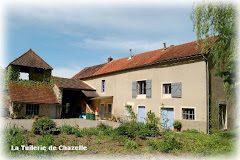 |
| Was this priory the church I was looking for? |
 |
| The oratoire in Maizeray |
When we came home I contacted the webmaster of "Le site sur l'Art Roman en Bourgogne", who replied promptly. He did not know what the church looked like, or in what state it was, but he was quite adamant that the church was near the oratoire in the village. He even sent me a photo of this oratoire, which to me looked like a cross between a war memorial and one of those road chapel one sees a lot in Germany. In any case, the priory was not what he was looking for, and that is why I put Maizeray for the time being on hold.
 |
| The remains of a church wall? |
 |
| Cadole or chapel? |
1. Behind the semicircular wall there were several traces of rubble, which might well be the remains of a wall.
2. In front of the oratoire there was a cadole (a semicircular agricultural shed, often built in dry stone) as you can find by the dozen in the fields around here. Someone with an overabundance of fantasy could see the remains of a chapel in this thing.
3. Finally we found, near the oratoire some sort of milestone with strange inscriptions. With my ever present fantasy I could recognise the papal keys in the coat of arms of Cluny.
 |
| Mile stone? Papal keys? |
There was not much more to see there, and after having duly photographed every stone that might have any relevance, we got into the car, left the parking area near the oratoire, and turned into the road leading home. And that is where it happened; from the corner of my eye I spotted a church window in the facade of a house standing at the bottom of the knoll the oratoire was on. I shouted stop, the driver made an emergency stop, and we were able to photograph this Romanesque gem, in able to preserve it for posterity.
The moral of this story : don't give up too easily, at the end of the day it is dogged that does it!
Practical information (courtesy of Eduard van Boxtel) : Church Saint-Pierre in Genouilly, 11th century, 3*
Church Notre-Dame-de-l'Assomption in Germagny, 12th century, 3*
Former abbey (Maison Chaumont) in Germagny, 12th century, ?*
Former church (ruin) Saint-Christophe in Le Puley, 12th century, 4*
Former church (habitat) Saint-? in Maizeray (Saint-Martin-du-Tartre), ?th century, 0*
Church Saint-Martin in Saint-Martin-du-Tartre, 11th century, 3*
For our own website, click here.
 |
| Found, the former church of Maizeay! |





